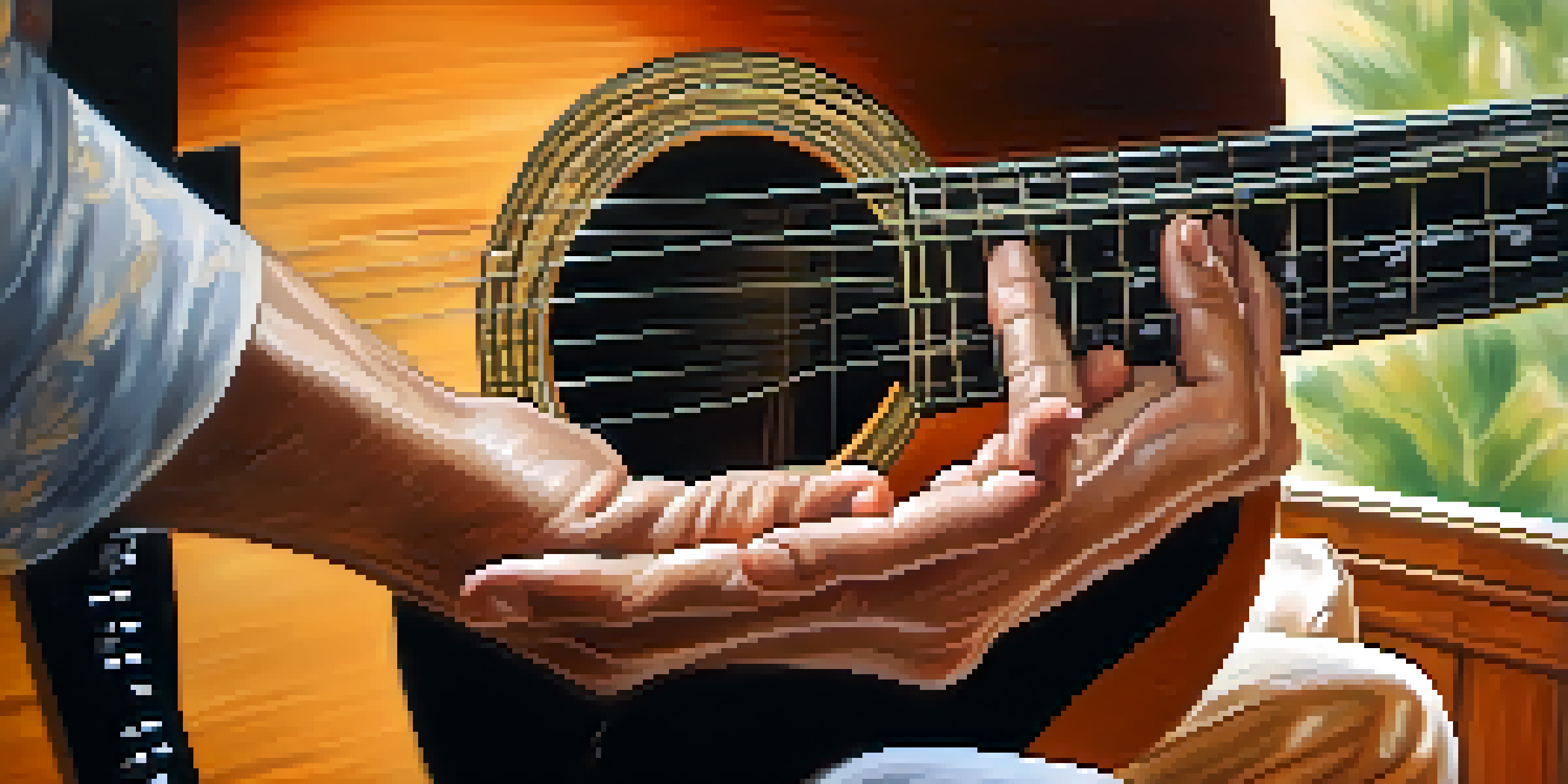Warm-Up Exercises to Overcome Guitarist's Hand Tension

Understanding Hand Tension in Guitarists
Many guitarists experience hand tension, which can lead to discomfort and hinder performance. This tension often arises from prolonged playing or improper technique, making it crucial to address it. Understanding the causes of hand tension is the first step towards finding a solution.
The more you practice, the better you get, but it’s also important to practice smart.
Think of your hands like a rubber band; if you stretch them too much without any relaxation, they can snap or lose their elasticity. Likewise, without proper warm-up exercises, your hands may become overly stiff and tense. Recognizing the importance of warming up can drastically improve your playing experience.
By incorporating simple warm-up exercises into your routine, you can significantly reduce hand tension and enhance your overall guitar playing. These exercises will not only prepare your hands but also promote better technique and prevent injuries.
The Benefits of Warm-Up Exercises
Warm-up exercises offer a plethora of benefits for guitarists, starting with increased flexibility and mobility in the fingers. Just like athletes stretch before a game, musicians need to warm up to prepare their muscles and joints. This flexibility allows for smoother transitions between chords and notes.

Furthermore, these exercises can help improve your muscle memory, making it easier to play complex pieces with ease. When your fingers are accustomed to movement through warm-ups, you're less likely to fumble during a performance. It's like training your fingers to dance across the fretboard effortlessly.
Address Hand Tension for Better Playing
Understanding and addressing hand tension is crucial for improving comfort and performance in guitar playing.
Additionally, warm-ups can foster better blood circulation in your hands, reducing the risk of cramping or fatigue. This is particularly important for guitarists who play for extended periods, as it keeps your hands cool, calm, and collected.
Simple Finger Stretching Exercises
One of the easiest ways to warm up is through finger stretching exercises. Start by gently stretching each finger, holding the position for about 10 seconds. This not only increases flexibility but also prepares your fingers for movement across the strings.
Warm-up is essential; it prepares your body and mind for the performance ahead.
You can also try spreading your fingers wide apart and then bringing them back together. This simple exercise mimics the motions you’ll use while playing and can help alleviate tension. Think of it as giving your fingers a mini workout before the main event.
Incorporating this stretching routine before you play can greatly enhance your comfort level and readiness. Remember, just like any exercise, consistency is key to seeing results.
Wrist and Hand Mobility Exercises
Wrist and hand mobility is just as important as finger flexibility. To warm up your wrists, try rotating them in circular motions, both clockwise and counterclockwise. This promotes greater range of motion and helps prevent stiffness that can lead to tension.
Another great exercise involves placing your palms together in a prayer position and gently pressing them against each other. This not only stretches the wrists but also engages the forearm muscles, preparing them for the demands of playing guitar.
Warm-Up Exercises Enhance Flexibility
Incorporating warm-up exercises increases finger flexibility and reduces the risk of cramping or fatigue.
By incorporating these mobility exercises, you're setting a solid foundation for your practice or performance. Your hands will feel more agile and responsive, allowing you to play with confidence.
Scale Drills for Warm-Up and Technique
Incorporating scale drills into your warm-up routine is an effective way to combine practice with tension relief. Start with a simple scale, like the C major scale, and play it slowly, focusing on evenness and clarity. This not only warms up your fingers but also reinforces your technique.
As you grow more comfortable, gradually increase your speed while maintaining clean notes. This process is akin to training for a marathon; you start slow, and as you build endurance, you can push your limits further. The goal is to keep your fingers loose and free from tension.
Regularly practicing scales as part of your warm-up can lead to improved finger dexterity and overall comfort while playing. You’ll find that tackling challenging pieces becomes much easier when your fingers are well-prepared.
Using a Metronome for Rhythm and Timing
A metronome can be an invaluable tool during your warm-up routine. By setting a slow tempo, you can focus on playing your warm-up exercises with precision and accuracy. This practice not only helps with timing but also ensures that you’re playing without unnecessary tension.
Try playing scales or finger exercises with a metronome, gradually increasing the tempo as you improve. This method is similar to building muscle; you start with lighter weights and progressively add more as you gain strength. The key is to maintain a relaxed posture while playing.
Personalized Routines Boost Performance
Creating a personalized warm-up routine tailored to your specific tension areas can lead to improved playing and reduced discomfort.
Incorporating a metronome into your warm-up routine can enhance your overall musicality and help you develop a strong sense of timing. As your rhythm improves, so will your confidence in your playing.
Creating a Personalized Warm-Up Routine
Crafting a personalized warm-up routine tailored to your needs is essential for overcoming hand tension. Start by identifying the specific areas where you feel the most tension, whether it’s your fingers, wrists, or forearms. This self-awareness will guide you in selecting the right exercises to include.
Consider combining stretching, mobility exercises, and scale drills into a cohesive routine that you can follow daily. Just as every musician has their unique style, your warm-up should reflect your individual playing habits and challenges. Feel free to adjust your routine as your skills evolve.

With a dedicated warm-up routine in place, you’ll find that not only does your tension decrease, but your overall playing improves. Soon, you’ll be able to enjoy your guitar sessions with greater ease and less discomfort.